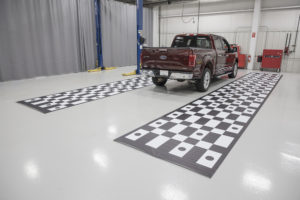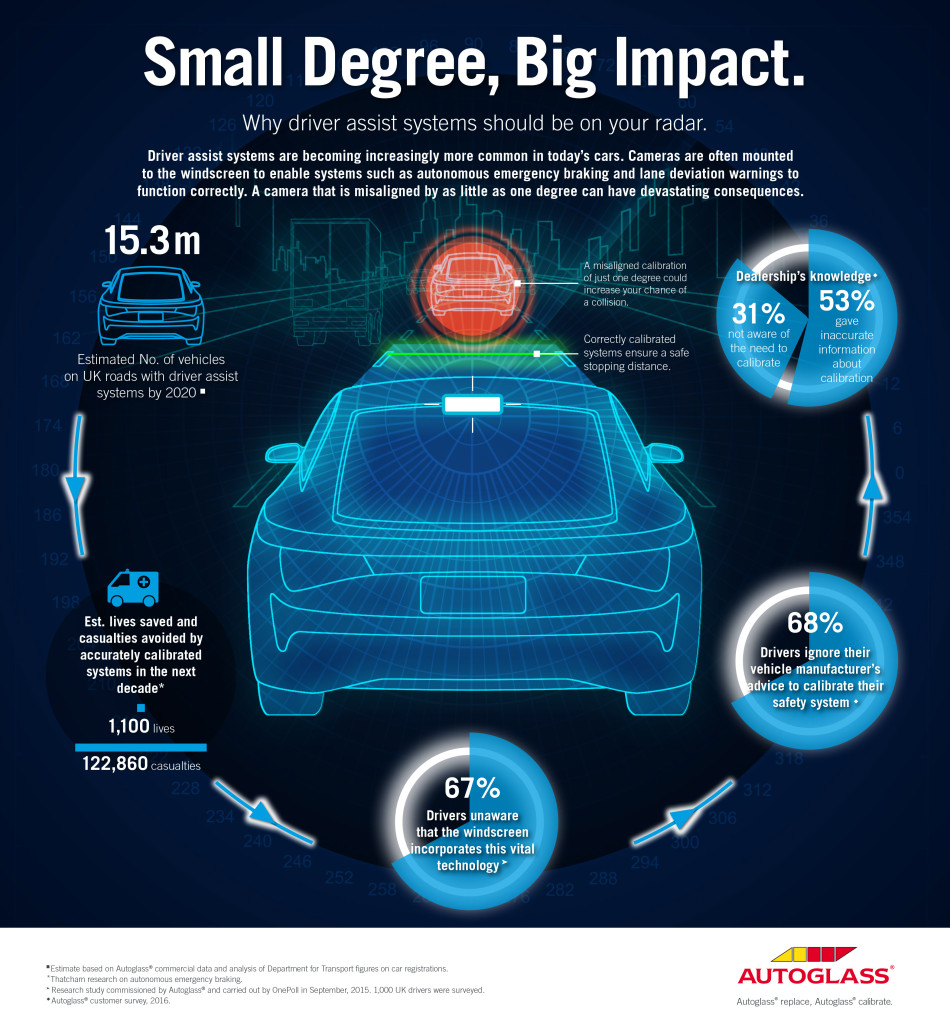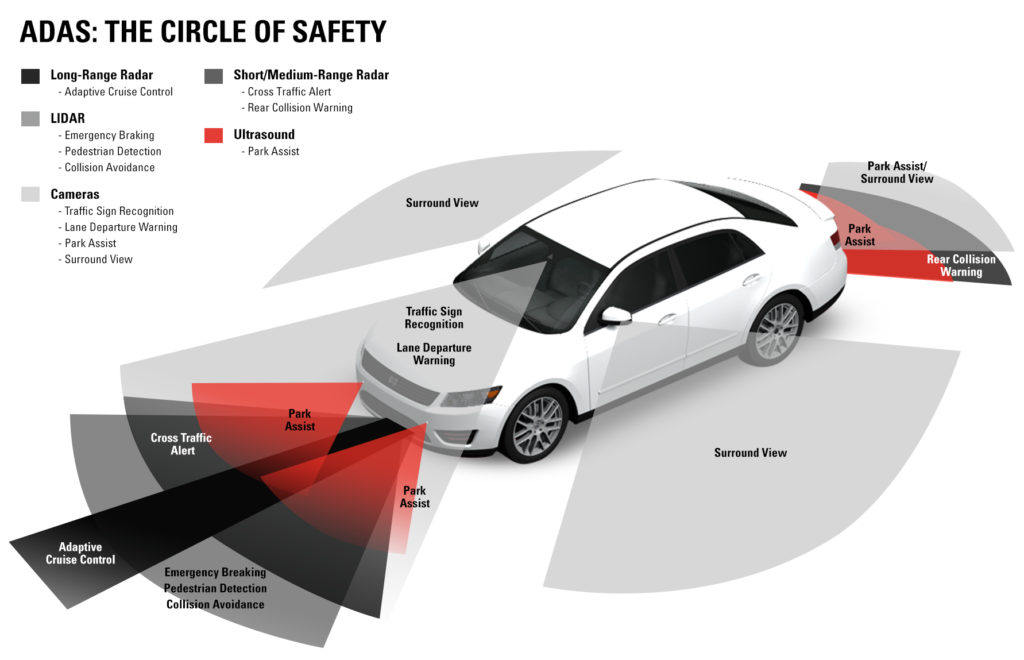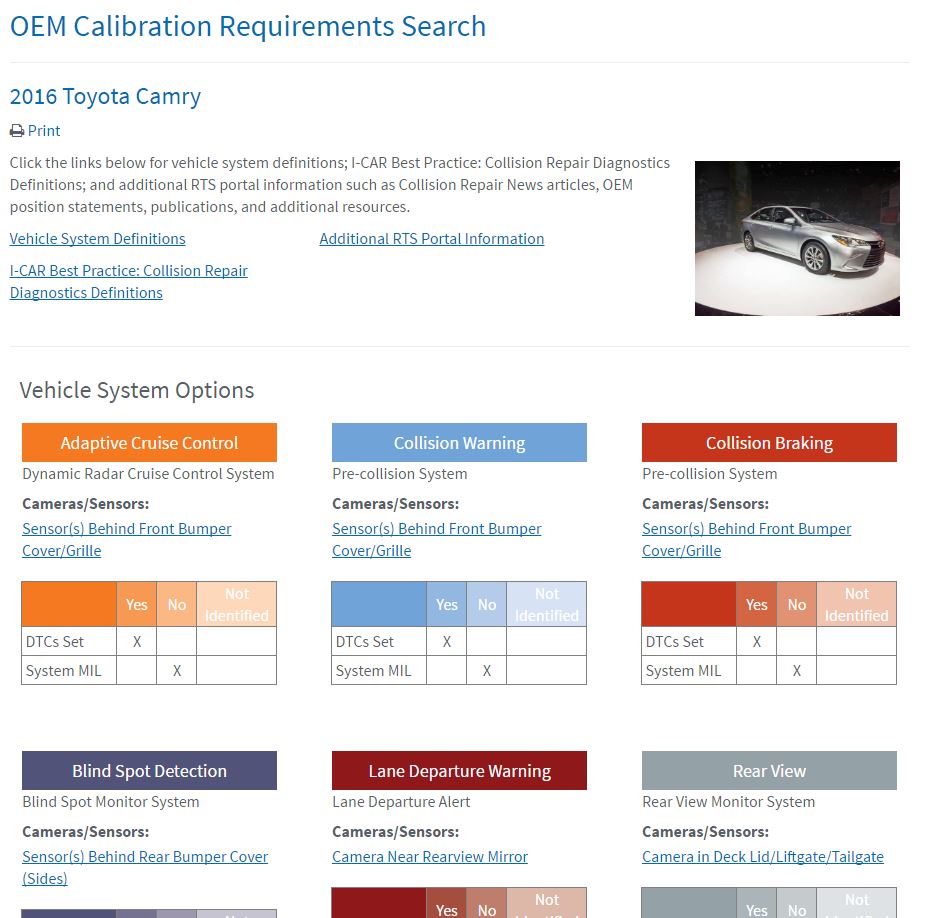
I-CAR guest column: Post-repair calibration essential for safety
By onAnnouncements | Associations | Education | Market Trends | Repair Operations | Technology
Editor’s note: In the latest in an I-CAR series on collision repair issues, industry technical relations director Jason Bartanen provides a further industry wake-up call on the need to properly calibrate safety systems following a collision — or perhaps just in the course of normal mechanical service and repair, as Hunter Engineering has observed.
For more on the topic, check out our February calibration coverage featuring Bartanen, past coverage of an auto glass industry highly cognizant of the issue and the upcoming SCRS Repairer Roundtable in Pittsburgh. And of course, I-CAR’s new OEM Calibration Requirements portal, discussed further below.
By Jason Bartanen
While the debate around pre-scanning and post-scanning rages on, there is a step that often gets overlooked in the repair process. This step is just as, if not more, important as pre-scanning and post-scanning.
Post-repair calibration, or aiming, is essential for many of today’s advanced driver assist systems (ADAS) to function properly. Failing to perform the OEM ADAS calibration/aiming procedures compromises complete, safe and quality repairs.
Post-repair calibration often gets incorrectly lumped in with the post-scanning debate. While performing a post-scan may be sufficient for some systems, there are many that require significantly more steps than simply hooking up a scan tool and clearing codes.
In this article, we’ll take a closer look at what post-repair calibration/aiming is, why it’s imperative and some tools that you can use to help identify when it’s required — yes, required.
Aiming at the target
Even if you’re not an avid hunter, the following analogy might help to understand why post-repair calibration/aiming is important:
Let’s say you’ve been putting in some extra hours at the shop, saving up for a new scope for your rifle before you head out on a big-game hunting trip. You’ve had your eye on that perfect scope for a while and you’re finally ready to make the investment, knowing it’ll help you bag the monster buck that will be the envy of all your hunting partners and, surely, put you in the record book. (Hey, a boy can dream, can’t he?)
You buy your new scope, mount it to your trusty rifle and hit the road for the trip of a lifetime. Not long after getting situated, you see what you’ve been dreaming about, just over the ridge. As it gets closer, your heart starts to beat a little (or a lot) more rapidly. You take aim, pull the trigger, and — you miss.
How can an expensive scope work so poorly?! It’s not the scope’s fault; it’s your fault for not ensuring the scope was properly calibrated.
While you could see perfectly fine through the scope and you mounted it in the exact same place your old scope was, you never took the time to sight it in properly. The same concept goes for many of the cameras and sensors on today’s ADAS-equipped vehicles.
The only difference is this time, instead of missing a trophy buck, it doesn’t see the vehicle in front of your customer, fails to alert the driver and/or slow the vehicle, and causes another collision.
Does it really make a difference?
A camera mounted a couple of millimeters too high or at an angle a few degrees off could be detrimental to the accuracy of adaptive cruise control, collision braking, lane-keep assist, or other collision mitigation systems. Vehicle makers have precise steps that are required for many of today’s ADAS parts. They also have explicit parameters for when an ADAS part requires calibration/aiming.
There are undoubtedly many stories about improper calibration/alignments causing issues, many of them likely true. An example of an improper calibration/aiming recently happened in our market. A late-model vehicle, equipped with collision braking, was repaired, but the camera wasn’t calibrated/aimed properly; instead, the camera ended up pointing upwards just a few degrees.
While a few degrees may not seem to be much of a problem, and is not even detectable by most human eyes, angle errors multiply in magnitude as cameras project out a few hundred feet in front of the vehicle.
In this case, as the vehicle was traveling towards an overpass, the system saw the road above, believed it to be a vehicle, and engaged the brakes; all because the camera was aimed too high.
Fortunately, there was no vehicle immediately behind the improperly repaired vehicle, or that driver would likely have been involved in a rear-impact collision. Conversely, had there been a vehicle immediately in front of this customer’s newly repaired vehicle, the system may not have detected that vehicle and caused a collision.
It isn’t just cameras that require calibration. Many distance-sensing sensors also require calibration following removal or replacement. The process is performed to “teach” the sensor how far objects are from the sensor. If a parallel-parking sensor doesn’t recognize 1 millimeter versus 1 meter, there is a chance the vehicle could parallel-park itself right into another vehicle.
Identifying calibration/aiming requirements
There are a number of situations that vehicle makers will require calibration/aiming on ADAS parts and systems. That criteria isn’t always limited to part replacement. There are many instances where calibration/aiming is required if the camera or sensor is removed and installed, if the mounting location is damaged, if the tire size changes, if a wheel alignment is performed, or if the windshield is replaced.
Just because the camera or sensor doesn’t require replacement, and even if it’s not damaged, there are many cases where calibration/aiming is still required — yes, required.
In addition to the criteria for calibration/aiming, there are also several requirements for the calibration/aiming procedure. Many procedures require targets placed at precise locations. These locations are not universal, even within a vehicle maker’s lineup. This is due to length and height variations between models. Often times, the technician performing the calibration/aiming procedure will have to apply math including geometry principles to ensure the proper target location.
In addition to the targets and calculations required to properly locate the targets, there are often other requirements for the area where the calibration/aiming procedure is to take place.
For example, the technician may need several feet open in front of, or to the side of, the vehicle. Or the vehicle may have to be placed on a flat surface (with only minor variance from the front to the back of the vehicle). Even lighting requirements may need to be considered (not too dark, but also no shadows).

To determine the exact target location and any other location requirements, access to the vehicle maker’s service information is required. Simply estimating the location and height of the targets is a recipe for disaster. OEM information is also required to determine which conditions necessitate a calibration/aiming requirement for the various sensors and cameras that are responsible for object detection on many collision mitigation systems.
To assist and simplify the OEM information process, I-CAR has developed a new tool to help point repair professionals in the right direction.
The I-CAR OEM Calibration Requirements Search Tool
At the SEMA Show in 2016, I-CAR announced the release of its new OEM Calibration Requirements Search Tool. I-CAR has invested thousands of hours in the development of this tool, so that industry professionals don’t have to spend valuable hours researching each vehicle option to identify if, or when, a calibration/aiming procedure is required.
The search tool is accessible to any industry professional who has access to the I-CAR Repairability Technical Support (RTS) website (www.i-car.com/RTS); this includes I-CAR Gold Class shops, Platinum individuals, I-CAR volunteers and instructors, I-CAR members, professionals who train with I-CAR on a regular basis, and daily or yearly subscribers to the website.
The tool allows users to select the make, model and year of the vehicle. (Currently the tool offers coverage for 2016 model year vehicles, with more being added on a regular basis.) The search results page for each vehicle is broken into two main areas: vehicle systems options and the cameras and/or sensors that support that option.
The vehicle systems options portion of the search results page informs users which options the vehicle could possibly be equipped with. It also indicates which camera(s) and/or sensor(s) that system uses, where the camera(s) and/or sensor(s) are located, whether a Malfunction Indicator Lamp (MIL) on the dash will illuminate if there is a system error, and whether a Diagnostic Trouble Code (DTC) will set if there is a system problem.
Many of the advanced driver assistance systems will not set a MIL dash light, but will frequently set a DTC; this is why we cannot base decisions to scan on the presence of a MIL, or lack of.
The second portion of the search results page shows what the vehicle maker calls the camera(s) and/or sensor(s). This information is helpful when searching vehicle maker information for part replacement and calibration/aiming procedures.
This section also lets users know which conditions necessitate camera(s) and/or sensor(s) calibration/aiming procedures. Additionally, this section indicates if a scan tool is required, if there are other special tools required (aiming targets, for example), and if the system will set a DTC if it isn’t calibrated/aimed or if the procedure is done improperly.
Having this information easily accessible during the damage analysis/blueprinting process can save valuable time and allow for more accurate damage assessments and repair plans. Knowing early on that the vehicle will have to undergo an aiming/calibration procedure will reduce surprises later in the repair process — or even worse, after the vehicle is delivered back to the customer.
Take the Necessary Steps
 While pre- and post-scanning are important steps in the repair process, if the required calibration/aiming of those systems isn’t done, scanning alone may not enable the vehicle systems to function properly. Always identify the ADAS options on the vehicles being repaired, understand the parameters that will require calibration/aiming, access the OEM information for the calibration/aiming procedures and plan ahead for those procedures. Following each of these steps will help achieve a complete, safe and quality repair.
While pre- and post-scanning are important steps in the repair process, if the required calibration/aiming of those systems isn’t done, scanning alone may not enable the vehicle systems to function properly. Always identify the ADAS options on the vehicles being repaired, understand the parameters that will require calibration/aiming, access the OEM information for the calibration/aiming procedures and plan ahead for those procedures. Following each of these steps will help achieve a complete, safe and quality repair.
Jason Bartanen is the director of Industry Technical Relations at I-CAR, a not-for-profit education, knowledge and solutions organization designed to support the evolving needs of the collision repair inter-industry. Bartanen leads I-CAR’s Repairability Technical Support Initiative. He is also a member of the SkillsUSA National Collision Repair Technology committee and an advisory committee member at Fox Valley Technical College and Northeast Wisconsin Technical College.
More information:
I-CAR Repairability Technical Support portal
I-CAR OEM Calibration Requirements Search portal
Images:
Calibration mats are positioned along the left and right sides of the 2015 Ford F-150 to recalibrate the surround view cameras. (Provided by I-CAR)
A target is placed behind a 2017 Honda Odyssey to recalibrate a lane-watching camera’s aim. (Provided by I-CAR)
Believing that by 2020, 40 percent of the country’s fleet will require calibration following a windshield replacement, Autoglass last year expanded a pilot calibration program across its entire United Kingdom operations. (Provided by Autoglass)
Not only does a shop need the right equipment to calibrate a vehicle, they might also need enough work space to calibrate the various systems. This could require additional space in front of the bay as large as 32.8 feet (10 meters) by 16.4 feet (5 meters) and demand various clear, level spaces within that rectangle. (Provided by Hunter)
This screenshot from the I-CAR Repairability Technical Support portal shows the new calibration database announced Nov. 1, 2016, by I-CAR. (Screenshot from rts.i-car.com)
This screenshot from the I-CAR Repairability Technical Support portal’s new calibration database shows possible ADAS options and repair considerations on the 2016 Toyota Camry. (Screenshot from rts.i-car.com)
I-CAR industry technical relations director Jason Bartanen is shown. (Provided by I-CAR)





